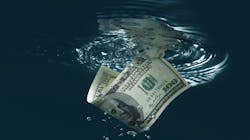By now, historic investments in our nation’s water infrastructure as part of the Biden Administration’s Infrastructure Investment and Jobs Act (IIJA) have begun to flow to cities and municipalities across the country.
The largest ever allocation of funding for several sectors — including water, wastewater, and stormwater — as well as the breadth and depth of programs included in the law highlight its historical significance. For instance, funding allocations for over 350 distinct programs across more than a dozen federal departments and agencies are outlined throughout the bill’s several hundred pages. A total of $55 billion allocated to the U.S. Environmental Protection Agency (EPA) is the largest award granted in the agency’s history.
The significant expansion of funding to improve drinking water and wastewater infrastructure under the IIJA includes a focus on lead service line removal and replacement, and targeted treatment for contaminants such as PFAS. Allocations include $15 billion over five years to the Drinking Water State Revolving Fund (DWSRF) for lead service line replacement and $1 billion over five years to the Clean Water State Revolving Fund (CWSRF) to address emerging contaminants.
The money is expected to help stimulate water projects across the nation and result in a flood of opportunities for private sector vendors, suppliers, contractors, and investors — but only if those funds are accessed by the communities that seek them.
That’s why, almost two months after the bill’s signing into law, the Administration made available an online guidebook so that applicants could read the legislation in its entirety and quickly sort and filter programs by agency, issue, or eligible recipient to better understand the available funding. Described by the White House as “a roadmap to the funding available under the law,” the guidebook explains, in as much detail as currently available, how much funding is available at the program level.
“Our primary goal,” says the guidebook’s preface, “is to help our partners across the country know what to apply for, who to contact for help, and how to get ready to rebuild.”
Several industry groups have also developed their own guidance on the bill, including the American Water Works Association (AWWA). The organization has compiled a list of state contacts, highlights of the law, process, requirements, resources, and news, available in a free resource available online.
To further combat any confusion, White House Infrastructure Implementation Coordinator Mitch Landrieu recommended in February that governors across the nation appoint their own infrastructure coordinators to manage the flow of funds to their states.
“This individual would work with your budget team and across departments responsible for transportation, water, broadband, and energy investments to coordinate implementation of the various infrastructure programs, perhaps using a structure similar to the Infrastructure Implementation Task Force created by the President,” Landrieu wrote in a letter to state governors.
“We know that needs, capacity, and challenges can vary widely by locality,” he wrote. “We need to make sure our programs reflect these realities across your state and our country, and having a senior, single point of contact in your office will help ensure that issues get elevated appropriately and rapidly.”
Indeed, the funding has been dispersed rather quickly, because the IIJA is not simply an authorizing bill but an appropriating bill for many existing programs.
“This is true [particularly for] the water funds,” Aimee Ghosh, a lawyer with Pillsbury Law’s public policy group in Washington, D.C., said. “This means that we’re not waiting for the appropriations legislation and then a regular appropriations cycle to see that money actually being made available to be obligated and released by the agencies.”
The bulk of the water infrastructure funds are already moving through existing EPA programs, including the DWSRF and the CWSRF (collectively, SRFs). Under the IIJA, these SRFs were boosted to nearly six times the level of their recent annual appropriations, for an average of $6.14 billion per fiscal year (FY).
The IIJA also expands and funds the Small, Underserved, and Disadvantaged Communities Grant Program. While the program received $25.8 million in FY 2021, new provisions will boost that number to $5 billion between FY 2022 and FY 2026. The program, which assists public water systems in certain communities to meet Safe Drinking Water Act requirements, has been the subject of much scrutiny lately because of the language used to describe communities that would receive funding under IIJA provisions.
The National Association of Clean Water Agencies (NACWA) is one group that has called for clearer guidance, particularly as it relates to how the term “disadvantaged community” is interpreted, since the IIJA calls for 49 percent of funds to be set aside for these groups.
“Many states have traditionally had overly restrictive requirements on what types of communities will qualify as disadvantaged,” the agency wrote in a letter, recommending that EPA should ensure that the funds were made available to communities throughout the U.S., regardless of technical or financial capacity or size.
In response to the NACWA letter, EPA issued a reply, stating: “Every state in America has disadvantaged communities and these communities have never received their fair share of federal water infrastructure funding. Through the Bipartisan Infrastructure Law, states have an unprecedented opportunity to correct this disparity. EPA will be working with states every step of the way. EPA is identifying the tools, resources and targeted technical assistance that will best support communities and states in achieving these goals.”
At the time of this writing, Congress is still working on an omnibus spending bill for the year. In mid-February, lawmakers issued a stop-gap, extending the deadline for a Continuing Resolution to keep federal funding flowing through March 11.
That means that existing programs will continue to receive funds at Fiscal Year 2021 levels, in addition to any supplemental money appropriated in the IIJA — but newly authorized programs under the bill will not be funded until a spending bill has been passed.
“A great deal of money was appropriated in the Infrastructure Investment and Jobs Act, including the $15 billion for lead service line replacement, $9 billion to address emerging contaminants, and a lot of money for the state revolving loan fund programs,” Tommy Holmes, legislative director for AWWA said. “We’re expecting to guidance from EPA in early March on implementation of these programs. We look forward to Congress finishing work on FY 2022 spending and appropriating money for the additional efforts authorized, but there is money to work with now to aid water infrastructure and treatment.”
While we wait on Congress, EPA is set to provide additional guidance in the coming months about implementation for new programs funded under the IIJA. Only then will states be able to issue their own notices and solicit applications for funding. WW
Published in WaterWorld magazine, March 2022.




